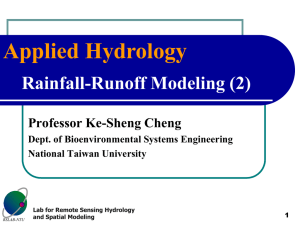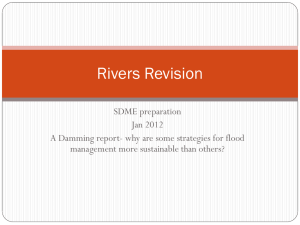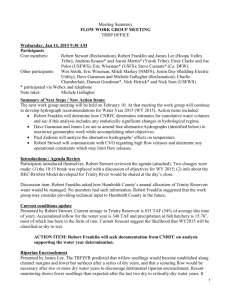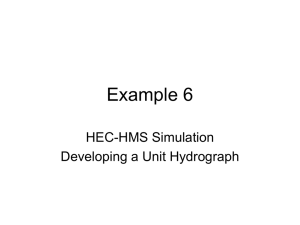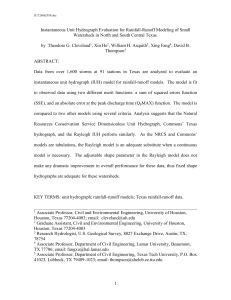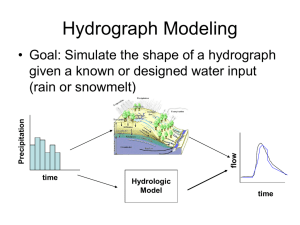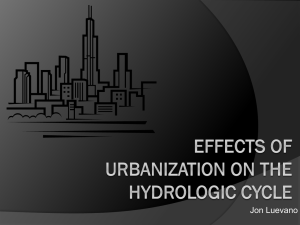rmc presentation
advertisement
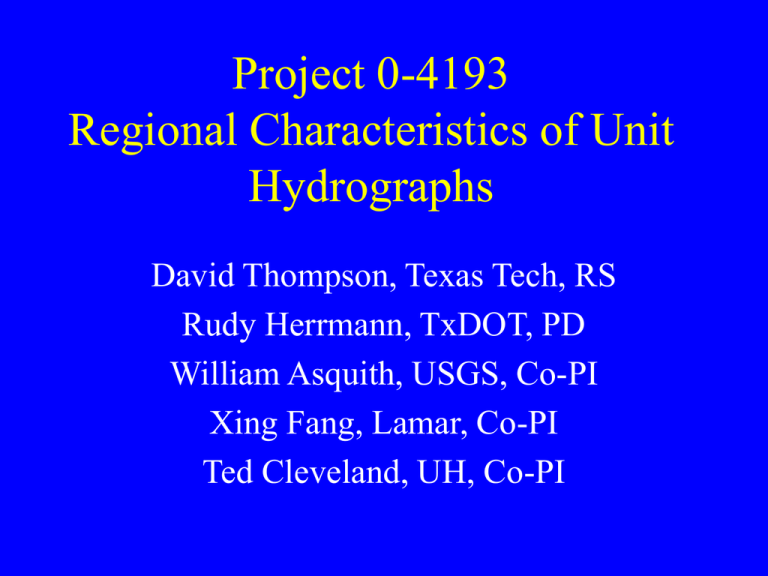
Project 0-4193 Regional Characteristics of Unit Hydrographs David Thompson, Texas Tech, RS Rudy Herrmann, TxDOT, PD William Asquith, USGS, Co-PI Xing Fang, Lamar, Co-PI Ted Cleveland, UH, Co-PI Unit Hydrograph • A unit hydrograph is the hydrograph of runoff that results from a unit pulse of effective precipitation (runoff) distributed evenly over a watershed over a specific duration of time. • Unit hydrograph theory assumes that watershed dynamics behave in a linear fashion. Objectives • Is the NRCS Dimensionless unitgraph representative of Texas hydrology? • If not, then can an alternative method be developed? Tasks • Literature review (complete) • Assembly of Database (complete) • Development of unit hydrographs from database (in progress) • Comparison with NRCS unit hydrograph (in progress) • Regionalization of computed unit hydrographs (in progress) Instantaneous Unit Hydrographs • The instantaneous unit hydrograph is a transferfunction that relates a unit depth of excess precipitation applied over a short interval to a runoff hydrograph at a watershed outlet. • Its principal advantage is elimination of storm duration in computing direct runoff hydrographs. • It can also be used to infer time-to-peak and timeof-concentration (classical concepts). IUH Concept Outlet Unit Depth at Time < 0; Discharge at Time < 0 Unit Depth at Time = 0; Discharge at Time = 0 Remaining Depth at Time > 0; Discharge at Time > 0 Remaining Depth Cumulative Discharge Unit Depth Discharge (Rate) Time Instantaneous Unit Hydrographs • Modeled the conversion of precipitation to runoff as a simplified hydraulic process that is a combination of a translation hydrograph, and a series (cascade) of linear storage elements. • Resulting IUH function is: t p 1 (t p ) N 1 tp exp( q(t ) A [ pz0 )] N 1 t _ bar t _ bar ( N 1)!(t _ bar ) A=watershed area, zo = input impulse depth : Watershed and precip. data p=exponent (decay rate), N=res. number (shape,delay), t_bar = timing parameter (location of peak) : IUH parameters that are estimated IUH Concept Outlet Unit Depth at Time < 0; Discharge at Time < 0 Unit Depth at Time = 0; Discharge at Time = 0 Remaining Depth at Time > 0; Discharge at Time > 0 Remaining Depth Cumulative Discharge Unit Depths Discharge (Rate) Time Instantaneous Unit Hydrographs • Preparation of precipitation and runoff data. – Separate base flow; remainder is direct runoff hydrograph (DRH). – Use a proportional rainfall loss model to ensure precipitation volume equals direct runoff volume. The fraction is called the runoff coefficient. – Recast actual data onto one-minute time intervals (approximate the impulses with short finite-time behavior) using linear interpolation and numerical differencing. Instantaneous Unit Hydrographs • Analysis to infer IUH parameters. – Convolve the one-minute rainfall impulses using the IUH function, adjust p, N, t_bar to minimize the RMS error in the model and observed DRH. (Note; A is fixed by the actual watershed characteristics, zo is the impulse as approximated by the one-minute derivative data. Instantaneous Unit Hydrographs File : #IUH_1_sta08057320_1973_0603.dat t he #SUMERR= .100000+100 #TMEAN=67.5#P_EXP=1.33 #NRES= 5 4.50E-02 Accum. Depth (inches) 4.00E-02 3.50E-02 3.00E-02 2.50E-02 2.00E-02 1.50E-02 1.00E-02 5.00E-03 0.00E+00 0 500 1000 1500 2000 2500 Time (minutes) #RATE_PRECIP #RATE_RUNOFF #RATE_MODEL • Typical result: The quality of the “fit” varies as measured by the relative error at the peak from 2% to 40% in some cases, in nearly all cases the peak rate is underestimated. (Error at largest peak in above example is 6.5%) Instantaneous Unit Hydrographs • Regionalization: – Type – I Aggregate Models (Ignore Watershed Character). • Station Data – Use median values of t_bar,p,N for IUH from all storms at a station. • Module Data - Use median values of t_bar,p,N for IUH from all storms in a module. • All Data – Use median values of t_bar,p,N for IUH from all storms. – Type –II Regression Models using Watershed Characteristics • All Data – Use power-law model values of t_bar,p,N for IUH from all storms. • Module Data - Use power-law model of t_bar,p,N for IUH from all storms in a module. • Station Data – meaningless in this context, nothing to regress. Instantaneous Unit Hydrographs File : #IUH_1_sta08057320_1973_0603.dat t he #SUMERR= .100000+100 #TMEAN=141.9#P_EXP=1.55 #NRES= 4 4.50E-02 Accum. Depth (inches) 4.00E-02 3.50E-02 3.00E-02 2.50E-02 2.00E-02 1.50E-02 1.00E-02 5.00E-03 0.00E+00 0 500 1000 1500 2000 Time (minutes) #RATE_PRECIP #RATE_RUNOFF #RATE_MODEL • Example for Type I – Station 08057320 2500 Instantaneous Unit Hydrographs • Type-II Power Law Model yi wo x1,i 1 x2,i 2 x3,i 3 x4,i 4 x5,i 5 x6,i w w w x1 x2 y1 t _ bar x3 y2 p x4 y3 N _ res x5 x6 • • w w w6 Area Aspect _ Ratio Raw _ Slope Area / Perimeter ShapeRatio Stream _ Slope Weights determined by minimization of RMS error between “observed” IUH parameters and the power law model. Predict values of IUH model (t_bar,p,N) from watershed characteristics, then use resulting IUH. Instantaneous Unit Hydrographs File : #IUH_1_sta08057320_1973_0603.dat t he #SUMERR= .100000+100 #TMEAN=40#P_EXP=1.53 #NRES= 4 4.50E-02 Accum. Depth (inches) 4.00E-02 3.50E-02 3.00E-02 2.50E-02 2.00E-02 1.50E-02 1.00E-02 5.00E-03 0.00E+00 0 500 1000 1500 2000 Time (minutes) #RATE_PRECIP #RATE_RUNOFF #RATE_MODEL • Example for Type II – Dallas Module Data 2500 Instantaneous Unit Hydrographs • Status: – – – – Deconvolution of 1600+ storms (essentially complete). Station Aggregate IUHs (complete). Watershed properties database (essentially complete) Regionalization methods to correlate watershed properties to IUH values in-progress. – Non-dimensionalization, calculation of traditional Tp, Tc values (pending). – Compare to NRCS DUH (started earlier in 2002, idle until regionalization analysis is firmed) Unit Hydrograph Derivation by Linear Programming • Linear programming is an alternative of deriving unit hydrograph [U] that minimizes the absolute value of the error between observed and estimated DRHs -- [Q] and [Q*], and also ensure all entries of [U] are nonnegative. • The general linear programming model is stated in the form of a linear objective function to be optimized (maximized or minimized) subject to linear constraint equations. Unit Hydrograph Derivation by Linear Programming • The constraints can be written (n=1,…,N) [Q ] [ n ] [ n ] [Q] or, * n PnU1 Pn1U 2 ... Pn M 1U M n n Qn Where n is a positive deviation, and n is a negative deviation of error n. • Fortran Programs have been developed to derive UH by linear programming for four different objective functions and for single or multiple events. Two-parameter Gamma UH is fitted to UH derived by linear programming. Error Analysis to Search Optimum UH • UH derived are applied to predict direct runoff hydrograph (DRH) for all events in the watersheds, and more than 12 error parameters are developed to evaluate errors between observed and predicted DRH. The key one used is to minimize the deviation between the peak values and the time of peaks for observed and regenerated hydrographs. Q Q pc po Z Q po 2 2 1 / 2 Tpo Tpc T po Gamma Unit Hydrograph Gamma Unit Hydrograph Gamma Unit Hydrograph
